
John WATTS 0438 346 544 watts@newsofthearea.com.au



Wendy BUSWELL 0415 124 960 wendy@newsofthearea.com.au
Kim TEOH 0491 008 417 teoh@newsofthearea.com.au
Doug CONNOR 0431 487 679 doug@newsofthearea.com.au


John WATTS 0438 346 544 watts@newsofthearea.com.au



Wendy BUSWELL 0415 124 960 wendy@newsofthearea.com.au
Kim TEOH 0491 008 417 teoh@newsofthearea.com.au
Doug CONNOR 0431 487 679 doug@newsofthearea.com.au
FROM Page 1
“The advocacy agenda spoke to the creation of 50,000 new jobs to offset those expected to
We
You can also Subscribe, for FREE, and we will email you the Printed Edition Flipbook each week.

Email us the exact wording and we will email back a proof and price ads@newsofthearea.com.au Phone us : Phone line Open
9am - 3pm daily (exc public holidays) (02) 4981 8882
Where you can pick up your paper
If your business stocks the paper and you are not listed here, please email us. media@newsofthearea.com.au
Bucketts Building
Bucketts Way Neighbourhood Centre Newsagent
Club Gloucester
Lovey's IGA
R & R Property
Gloucester Library
Gloucester Caravan Park
Hebbys Bakery
Yates & Twomey
Hannaford
&
be lost through a decline in coal mining, through economic diversification and post-mining land use; faster delivery of well-located homes with
enabling infrastructure; safer roads and better regional connections; a step-change in our visitor and export potential, including
the Newcastle Airport airfreight precinct; and long-term resilience to natural disasters; all of which need to be underpinned by more sustainable funding for local government,” the HJO said in a statement.
“Thank you to the Premier, Treasurer, Ministers, Shadow
Ministers and local Members for constructive engagement.
“We look forward to further collaboration to deliver tangible outcomes to craft a stronger, prosperous and more resilient future for the Hunter region.”
LAST week (22/10/2025)
NOTA reported pool users’ dismay about the chopping down by MidCoast Council of two mature shade trees at Gloucester Olympic Pool, and their concerns that more trees might be felled, leaving little shade.
Since that report the Council has explained why the trees were cut down and its plans for the future of the remaining trees.
“Two large London Plane Trees have been removed, one each side of the 50m pool, and will be
replaced with other shade trees in coming weeks,” explained a Council spokesperson.
“These trees have been removed as Plane Trees cause a number of issues around pools:
1. They have very invasive roots that seek out water, making their way into pool and stormwater pipework causing major works and expense. They can also work their way under paths causing them to lift. When the Hydro pool was built, works were
undertaken to restrict the root spread but recently, we have seen evidence that the roots are spreading towards the pool.
2. The leaf drop occurs during the season that the pool is open and the large leaves make their way into the pool blocking up leaf screens and causing the pool to overflow overnight when there are not any staff to constantly clear the screens.
3. Staff are required to spend several hours each day during the leaf
drop collecting the leaves before they enter the pool. This is either an additional expense or has to be undertaken by staff that are employed to watch the patrons in the pool.
4. The cost of trimming/pruning these trees is expensive, is required every one to two years, and doesn't eliminate the issues and costs to pool operations.
5. The plan is to remove the one remaining London Plane tree once the newly planted trees have established and started providing more shade. This staged approach was undertaken to ensure as much shade as possible is retained during this change over of trees. The London Planes just outside the pool fence will remain.
“By replacing these trees with trees of a similar type to those closest to the hydro pool we will continue to have plenty of natural shade and will not be as impactful as the London Plane trees.”
MIDCOAST Council will soon begin resealing a number of sections of the Bucketts Way, at Gloucester, Krambach, Burrell Creek, Tinonee, and Belbora.
The work will involve placing a new bitumen seal over the existing road surface
to extend the life of the roadway and improve driving conditions.
Work was due to start on Monday 27 October and will take approximately two weeks to complete, weather permitting.
Traffic control will be in place during the

EARLY BIRDS
Sessions 2 to 4; 9am - 12pm
Our transition program, ‘Early Birds’ provides opportunities for students to visit the school and participate in classroom and playground activities. The program supports a smooth and positive transition experience from home to school for kindergarten class of 2026. The program fosters an environment of safety and belonging and allows students to commence kindergarten with confidence.
Successful Foundations provides children with the opportunity to actively demonstrate their knowledge with the context of the school, through play!
PARENT AND STUDENT SESSIONS
Session 1 (Term 3)
Tuesday 5th August 9:15-10:15am
Children can attend playgroup, 9:15-10:15am while parents/carers attend information session with school counsellor.
Session 2 (Term 4)
Tuesday 28th October 9:15-10:15am
Children can join Early Birds while parents/carers attend Information Session with Principal.
Students attend Early Birds transition program from 9am - 12pm. Pick up at the front office.
STUDENT SESSIONS
Session 3 (Term 4)
Tuesday 4th November 9-12pm
Parent’s kiss and drop for Early Birds.
Uniforms on display and available to purchase.
Session 4 (Term 4)
Tuesday 11th November 9-12pm
Parent’s kiss and drop for Early Birds.
Uniforms on display and available to purchase
ST JOSEPH’S PRIMARY SCHOOL
02 6558 1555
admin@gloucester.catholic.edu.au
www.gloucester.catholic.edu.au
works, and motorists may experience minor delays. Residents in affected areas will be notified directly, as on-street parking will be temporarily unavailable while crews are working.
“Resealing prevents water from penetrating the road surface, which helps avoid potholes and cracking,” MidCoast Council said in a statement.
“This proactive maintenance approach is the most cost-effective way to preserve road infrastructure and delay the need for expensive reconstruction.”
Learn more about roadwork across the area and view the MidCoast Road Strategy at https://haveyoursay.midcoast.nsw.gov.au/ midcoast-roads-hub




Page 1
measure, but there is a huge opportunity for the Hunter to build a permanent future by embracing agriculture,” Mrs Petrie said.
“Now of course we don’t mean planting wheat at Broke or running sheep over Mount Sugarloaf, what we’re talking about is value-adding, which will be an economic gamechanger for Australia.
“Data shows we could create roughly 88,000 new jobs and add $20 billion to the state’s economy if we embrace value-adding, and Newcastle and the Hunter are in a prime position to make this happen.”
The discussion paper
focused on how the region was uniquely positioned to take advantage of existing opportunities in food and fibre value-adding, and what future investment in training, processing and logistics would be needed.
“As farmers we see an enormous amount of raw commodities – things like wool and wheat – get shipped off overseas and sold back to us as expensive consumer products,” Mrs Petrie said.
“With targeted investment in skills, roads and rail, and a focus on processing and manufacturing along the route from farm to Port of Newcastle, the Hunter can move from powering the world to feeding and clothing
it and prosper in the process.
“Coal seam gas from Narrabri is not a futureproofing plan, it’s just a cheap sugar hit for the economy while it risks contaminating vital groundwater and the environment.
“We say there’s a better way, and here’s a more sustainable opportunity for the Hunter to seize.”
Practical recommendations from the report include:
• Invest in agricultural skills and training: Expand education programs in food science, logistics, and advanced manufacturing to prepare the workforce for new roles.
• Improve road and


rail infrastructure: Repair roads, upgrade total axle load limits, and support the creation of grain terminals, cool storage, and intermodal hubs to enhance flow of containerised products.
• Repurpose degraded mining land for renewables: Prioritise solar and wind projects on former mine and
By Kim TEOH
A GROUP of sewing enthusiasts gathered at the Gloucester Seventh Day Adventist church on Sunday, 19 October to create specially designed heart shaped pillows for breast cancer patients.
Organiser Beryl Landers told News Of The Area, “Being Breast Cancer Awareness Month, we want to make 30 of these special cushions to donate to hospitals for breast cancer patients so they provide underarm comfort post-surgery and serve as a symbol of care and support.”
power station sites to protect prime agricultural land.
• Prioritise food and fibre production: Reject the Narrabri Gas Project and any other risky proposal that threatens vital groundwater or agriculture.
• Encourage investment in niche processing and manufacturing: Offer incentives for food tech, value-adding and specialty production, diversifying the economic base.
With the tables all set for assembly-line action, coordinator Learne Collins explained the stations she had set up for various stages of the process:
- Assembling and pinning the heart cut outs for them to be sewn
- Sewing them and leaving a gap so the cushions can be filled
- Ironing the seams neatly
- Filling them with carefully weighed fillers
- Ensuring the pillow is filled out proportionately
- Sewing up the seams neatly. Beryl added that some



Read the full discussion paper at https://nswfarmers. us7.list-manage.com/track/ click?u=3070a9732a41dc27 01f01e90d&id=07be8176a6 &e=4ebecd0b97.
will be sent to aged care and children’s homes.
Attendee Deb van Aaist told NOTA she was really glad to be involved.
“The project is very close to my heart, having a family member affected by this illness,” she said.
“The difference that kindness can make to lifting the spirits of women going through the battle of their lives is clearly shown by the responses to receiving their comfort pillows.
“The love in every stitch is hopefully felt by each and every recipient.”


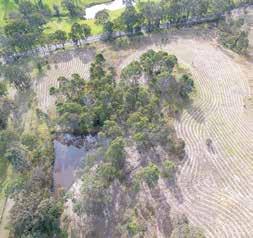
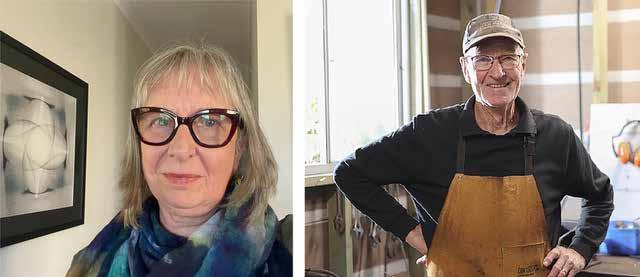
By John WATTS
ART lovers are in for a treat with the opening of an exhibition in the Gloucester Gallery, displaying a combination of photographic art and metalwork sculptures.
The photo works are by Rachel Saunders and the
metalwork is the creation of Michael Kolbe.
The exhibition is titled Simple Imaginings and all members of the public are invited to the formal opening on Saturday 8 November at 1pm.
Rachel first met Michael when she was Gallery Director and invited him
to be involved in a group exhibition she was planning to curate.
Michael creates striking metal sculptures from scrap, old tools, and square rods, showcasing his evolving creativity since 1995.
“My journey started in 1995 following a trip to Zimbabwe where I purchased
By Kim TEOH
“IT’S really quite simple to make these,” Lee Lawrence said, without even a glance at the intricate woollen mice
she was crocheting.
An avid supporter of animal rescue groups, Lee makes dog blankets and crochet mice for rescued cats.
Her journey started years
ago when she came across the RSPCA Sydney Adoption Centre in Yagoona.
She read in the local paper that the RSPCA was calling for dog blankets and
a small metal bird made from scrap which stirred my creativity, and phase one began with simple but appealing sculptures which were saleable and well received,” said Michael.
“Phase two some years later was instigated by posts by Harriet Mead, an exceptional English sculptor
coats, and faux mice and toys for cats.
Since she had a stash of wool and lived close by, she started crocheting blankets and mice for the charity.
This became such a fulfilling pastime that Lee bought extra wool from op shops and craft shops so she could give joy to more rescued animals.
Lee soon became a member of the Sydney Auxiliary and joined friends to fundraise for the RSPCA.
“Jane was one of them (those friends) and she coordinated donations of ‘woollens’ to send them to animal charities and rescue centres in NSW,” Lee said.
Right now we’re heading back out to 15 local communities across the MidCoast to provide you with an update on what we’re delivering in our region.
These sessions allow us to hear directly from community members and provide a chance to meet with senior Council staff and Councillors.
We look forward to sharing this update with you.
MidCoast Council Customer Service Point, Gloucester Tuesday 4 November 2.30 - 4pm
Also coming to other locations across the region.
Scan to learn more and for the full schedule of dates and locations.
midcoast.nsw.gov.au/conversations
Jane and Lee eventually went their separate ways; Jane to the Blue Mountains area, and Lee to Gloucester five years ago.
Since then, Lee has been sending her mice to Jane for distribution.
“Friends and other people who have heard about knitting or crocheting
and my work took a turn, creating sculptures from old tools which were extremely popular.
“Phase three began in March this year after spotting a sculpture made from square metal rod and I took to the idea with a vengeance, and some of the results surprised even me.
“Forging and shaping the metal is challenging and so rewarding.”
Rachel will exhibit her latest photo prints that she says reflect her love of traditional woodblock prints.
While each piece has photographic origins, they are simply imagined unique pieces.
Rachel explains that she is a printmaker with a difference and that she is excited to share her works in this exhibition.
“I feel my prints work well with Michael’s sculpted forms and in particular complement our shared love of birds and
for animal charities have donated wool and enabled me to carry on,” Lee said.
Lee has supported various knitting projects for Australian pet rescue groups.
Recently she even donated 50 mice for the Samaritan’s Purse’s “Operation Christmas Child” boxes.
“There are various knitting groups for animal rescue on Facebook which will welcome your support,” Lee added.
nature,” said Rachel.
“My prints are my own photos transposed and transformed into unique pieces, the composites evoking a new sense of place with the potential of becoming illustrations to, as yet, untold stories.
“I graduated from the Sydney College of Fine Arts and found work in a photographic studio as an assistant which led to my becoming a professional photographer working in some of the major advertising studios in Sydney.
“My move to Gloucester in 2012 reignited a passion for capturing the beautiful landscape and its both wild and domesticated inhabitants with a greater connection to the ever-changing weather patterns, cloud formations and the differing lightfall of the seasons.
“I like to combine images to create new scenes with a visual intricacy that tells new stories.”
The exhibition will run from 6 to 30 November.
“Anyone keen to learn to crochet mice or donate scraps of wool can come to Crafty Tuesday held at the Gloucester Seventh Day Adventist hall on Hume Street between 9.30-12,” said Lee.
Learne Collins, who runs Crafty Tuesday, said, “Bring along your craft projects and enjoy a relaxed morning in great company.
“Lee would be so glad to show you how to crochet mice.”
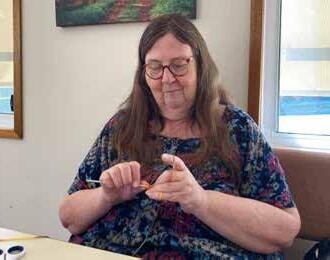
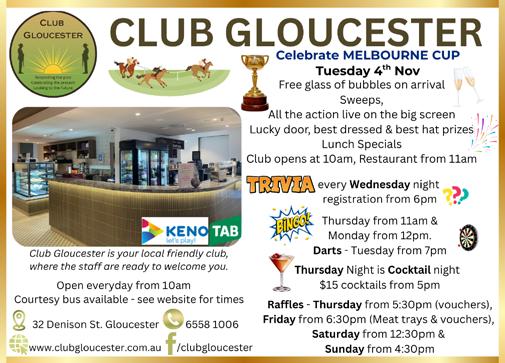
By Thomas O’KEEFE
RISING temperatures over Antarctica have been a major contributing factor to recent volatile weather along the East Coast, according to new information from the Bureau of Meteorology (BOM).
A “sudden stratospheric warming” (SSW) is to blame.
This is a documented weather scenario in which air temperatures high above the South Pole rise by 30 degrees or more in the space of a week.
This latest SSW began in late September.
According to the BOM, they are relatively rare in the Southern Hemisphere, but have the potential to disrupt weather patterns across the Australian continent for months.
Only two major SSWs have been recorded in the last 60 years: in 2002 and 2019.
Both those years immediately preceded devastating bushfire events, however they came on the tail of prolonged drought conditions and El Nino weather patterns, whereas 2025 has been exceedingly wet and a mild La Nina is on the horizon for the months ahead.
Last Wednesday, 22 October, was a stifling 40-degree scorcher along the coast.
BOM meteorologist Angus Hines described it as a “bubble of heat, moving over central Australia, coming east from northwestern NSW”.
“This hot wind blew from the desert towards the coast… causing temperatures to soar across the Illawarra, Sydney, the Central Coast, the Hunter and the Mid North Coast.”
BOM information shows that new records have been set for October.
Some overnight temperatures, however, dropped precipitously to around 15 degrees, confounding many who had started the evening dressed for Summer only to wake in the middle of a chilly wintry night.
When an SSE does occur over the South Pole, a meteorologically complex chain reaction ensues, which can eventuate in westerly winds hitting southern Australia, bringing warm, dry weather to the east.
“Cold fronts embedded in the westerlies also increase in number, leading to frequent bursts of strong winds and high fire danger days, and potentially an enhanced contrast in weather between the country's east and south coast,” said ABC Meteorologist Tom Saunders.
So far, in October alone, there have been a handful
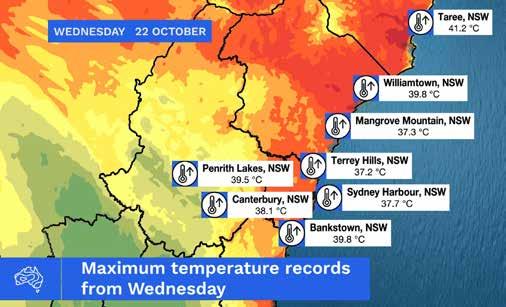
of “Extreme” fire danger days, which were flagged in forecasts of spiking temperatures, and followed relatively mild weather in the mid-20s.
BOM Meteorologist Felicity Gamble has pointed to a similar case of a weak, relatively unknown SSW
event in October 1988 that had weather patterns similar to 2025.
It may offer clues to what to expect for the rest of this year.
“November's rain prospects have also eased in recent model updates, and research suggests the
dominance of warmer and drier weather from an SSW can linger until January,” said Ms Gamble.
The coming clouds have one silver lining, at least, being “a suppression of super-cold polar stratospheric ice clouds, which are key to the chemical process that destroys ozone."
AS Australia’s social media ban for under-16s edges closer, children are already worried about losing touch with their friends.
But while the onus is on social media platforms to act, researchers at the University of South Australia (UniSA) say the real battle will be at home – where parents must enforce the rules, manage their children’s reactions, and help them adjust.
Child safety and wellbeing expert, UniSA’s Associate Professor Lesley-Anne Ey, says the key to a smoother transition is education, reassurance, and open, ageappropriate conversations.
The first step, she says, is understanding why social platforms matter to kids.
“Many children and teens use apps like Snapchat and TikTok to connect with their friends,” Assoc Prof Ey says.
“They’ve grown up with this technology - it’s part of who they are - and they’re used to communicating through videos, emojis, photos and filters.
“When the ban kicks in, kids may feel like they’re facing a social penalty where they won’t be able to connect with their friends in the same way.
“The fear of losing touch with friends is real, so parents will need to invite questions and show understanding and empathy about what their kids will see as a loss.
“Brainstorm alternative ways to stay connected.
“If they liked TikTok dances, an app like Just Dance could suit; if they want to chat, use closed group chats or messaging apps; and if they enjoy gaming, find multiplayer games where they can connect safely.
“Supporting kids through this is about empathy and keeping the lines of communication open.”
From December 10, major social media platforms including TikTok, Snapchat, Instagram, Facebook, YouTube and Reddit must take ‘reasonable steps’ to stop under-16s creating accounts.
While the new legislation aims to protect kids from harmful content, Assoc Prof Ey says its success depends on what happens at home – through education and consistent guidance.
“Parents should talk with their children about online safety – why it’s important to protect personal information like your full name, address and passwords; who it’s
Have Your Say
okay to connect with; and how to behave kindly and respectfully,” she says.
“They should also teach kids to think before they post anything – photos, comments or information – because once something’s online, you can’t take it back.
“Young brains are especially vulnerable to social media because they crave peer feedback and attention.
“This makes them more likely to take risks or react quickly without thinking about the consequences.
“Encourage kids to ask ‘Would I say this to someone’s face?’ or ‘Would I show this to my mum?’ before posting or commenting. If the answer is ‘no’, then it’s probably not appropriate.”
With rising rates of online bullying, coercion and sextortion, researchers say it’s vital that parents take the ban seriously.
“The social media ban isn’t ‘safetyism’, or evidence of a ‘Nanny State’; it’s an essential move to protect kids from online predators and risks,” Assoc Prof Ey says.
“Parents should educate themselves about the platforms and games their kids use so they can have informed conversations.


Non-judgemental, ongoing dialogue is essential.”
As children tend to imitate adult behaviour, parents can also be powerful role models.
“Avoid excess screen time yourself and set up screen-free times for the whole family, like dinner and bedtime.
“This makes boundaries predictable and shows your kids what a healthy balance looks like,” Assoc Prof Ey says.
“Connect with your kids. Show them how you can have fun together – whether it’s board games, movie nights, or taking advantage of daylight savings for a bike ride after dinner.
“The convenience of screens and social media has caused havoc.
“Perhaps we all need to wind the clock back and remember what life was like before screens.
“It’s time we took control –for our sake, and for the
safety and wellbeing of our kids.”
What parents need to know about guiding kids through the social media ban:
`• Get informed about new platforms and trends – Kids move quickly to new apps. Keep an eye on emerging platforms and talk about them before your child joins –explore the platforms, games and media kids are using and explore the benefits and risk of these
• Educate kids about online safety – Talk openly about the benefits and risks of the internet, what’s safe to share, how to protect personal information, and what to do if something online feels uncomfortable and even if they think they have done something wrong online. They need to know that you are always there to help them even if they have done something wrong.
• Have open and ageappropriate conversations –Talk about what they do and see online and how it makes them feel. Stay open and provide a safe place to share
• Understand and empathise – Acknowledge your child’s feelings of loss of freedom or control. Let them know you understand but explain that safety and their wellbeing comes first.
• Model healthy behaviour – Show balance in your own screen use and set familywide screen-free times (like during dinner or before bed).
• Create consistent routines – Make boundaries predictable with regular habits, such as tech-free zones or times.
• Encourage alternatives – Support hobbies, sport, and offline fun to keep kids socially connected in healthier ways. Arrange family or peer connection like movie or game nights.



